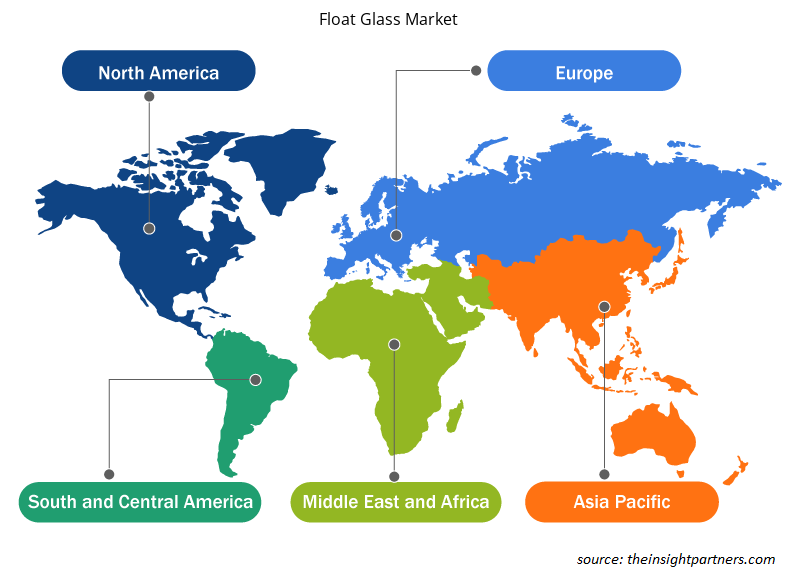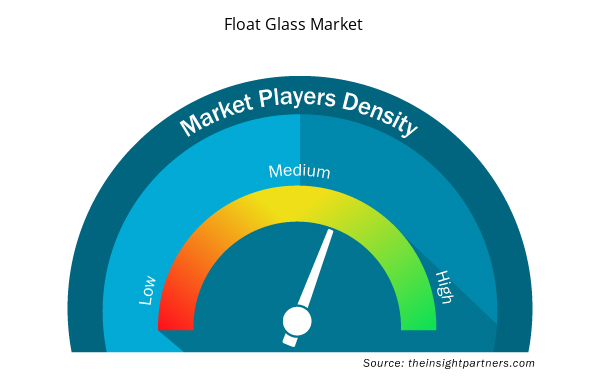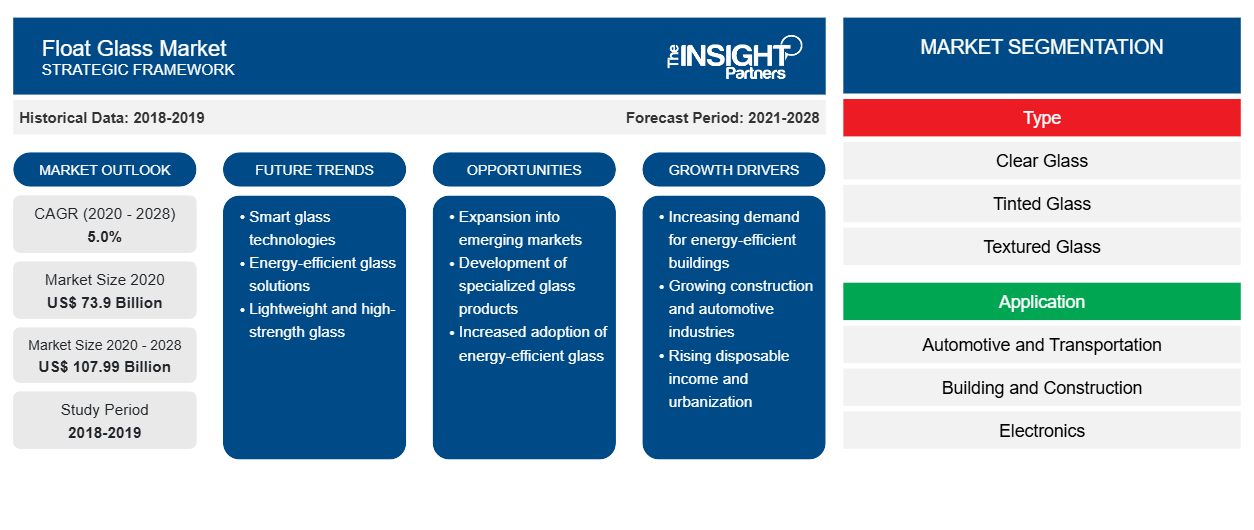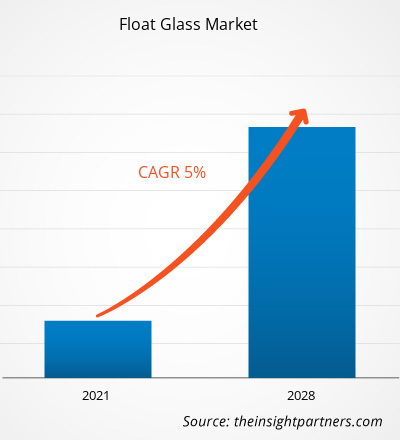Nel 2020 il mercato del vetro float era valutato 73.897,83 milioni di dollari USA e si prevede che raggiungerà 1.07.991,35 milioni di dollari USA entro il 2028; si prevede una crescita a un CAGR del 5,0% dal 2021 al 2028.
Il vetro float è un vetro estremamente liscio e privo di distorsioni che viene utilizzato in vari settori di utilizzo finale come edilizia e costruzioni, automotive, elettronica, solare, tra gli altri. È fondamentalmente realizzato versando il vetro fuso dal forno in una camera che contiene un letto di stagno fuso. L'aumento dell'uso del vetro float nell'interior design e nell'architettura moderna ha svolto un ruolo importante nell'aumento della domanda di vetro float e viene utilizzato in altre applicazioni edilizie e di costruzione che includono soffitti, pavimenti, vetri riflettenti, rivestiti, finestre, specchi, ripiani di tavoli e vetri isolanti. Inoltre, si prevede che il crescente uso del float nelle applicazioni automotive guiderà l'industria del vetro float nel periodo previsto.
Nel 2020, l'Asia Pacifica ha rappresentato la quota maggiore nel mercato globale del vetro float . Il crescente sviluppo del settore automobilistico e del settore edile e delle costruzioni sta guidando la domanda di vetri float nella regione. Anche il vasto settore automobilistico consolidato in paesi come Cina e India sta aumentando la domanda di vetri float in questi paesi. Insieme a questo, lo sviluppo e la maggiore penetrazione dell'industria solare nell'Asia Pacifica stanno guidando la crescita del mercato del vetro float nella regione.
Personalizza questo report in base alle tue esigenze
Riceverai la personalizzazione gratuita di qualsiasi report, comprese parti di questo report, o analisi a livello nazionale, pacchetto dati Excel, oltre a usufruire di grandi offerte e sconti per start-up e università
- Scopri le principali tendenze di mercato in questo rapporto.Questo campione GRATUITO includerà analisi di dati che spaziano dalle tendenze di mercato alle stime e alle previsioni.
La chiusura di vari stabilimenti e fabbriche in Nord America, Europa, Asia Pacifico, Sud America e Medio Oriente e Africa a causa della pandemia di COVID-19 ha ostacolato la catena di fornitura globale e i processi di produzione, i programmi di consegna e le vendite dei prodotti. Inoltre, le restrizioni imposte dai paesi in Europa, Asia e Nord America stanno influenzando la collaborazione aziendale e le opportunità di partnership. L'attuale pandemia di COVID-19 ha avuto un impatto significativo sul mercato del vetro float. Le interruzioni nella produzione e nella catena di fornitura hanno avuto un impatto negativo sul mercato del vetro float. Si prevede che la carenza di vetro durerà fino al 2021, causando interruzioni in una varietà di attività. L'offerta di vetro si sta restringendo ed è diventata più costosa da acquistare a causa di vari problemi, tra cui la pandemia mondiale e le tariffe internazionali. A causa della pandemia globale, molte fabbriche e produttori hanno dovuto sospendere o rallentare la produzione di vetro, rendendo estremamente difficile soddisfare la domanda attuale. Riavviare le fabbriche dopo essere state chiuse o aver prodotto a bassi livelli per un lungo periodo di tempo può essere estremamente impegnativo, soprattutto se le aziende non stanno operando a piena capacità a causa delle normative sulla salute e sicurezza. Inoltre, poiché le vaccinazioni contro il COVID-19 sono una priorità assoluta sia per il pubblico che per il settore sanitario, la disponibilità di vetro è stata reindirizzata alla causa che ha portato alla non disponibilità di vetro per altri settori, creando così una carenza di vetro sul mercato.
Approfondimenti di mercato
Aumento della domanda nel settore dell'edilizia e delle costruzioni
Il vetro float viene prodotto tramite un processo di fusione, in cui vetro riciclato , calce, sabbia silicea, potassa e soda vengono fusi in una fornace e fatti galleggiare su un letto di stagno fuso. Il vetro float viene sempre più utilizzato nel settore edile e delle costruzioni, che comprende i settori residenziale, commerciale e industriale. Il vetro float ha un alto grado di trasmissione della luce, la capacità di produrre una gamma di colori e opacità e una buona inerzia chimica, che ne ha aumentato la domanda nel settore edile. Il vetro float viene utilizzato per finestre e porte nel settore residenziale, per applicazioni sia estetiche che funzionali. Viene anche sempre più utilizzato nell'interior design e nell'architettura moderna. Nel settore commerciale, il vetro float è richiesto in quanto fornisce una superficie esterna attraente e di facile manutenzione. Il vetro float offre trasmissione della luce e del calore, influenzando la quantità di riscaldamento e raffreddamento richiesta all'interno di un edificio in base alle diverse stagioni e ai diversi climi. Il vetro float viene anche utilizzato come vetrine nei punti vendita al dettaglio grazie alla sua natura trasparente, durezza e facilità di pulizia. A causa dell'aumento delle preoccupazioni ambientali, c'è stata una domanda crescente di vetro float nel settore edile, poiché aiuta a ottenere la certificazione Leadership in Energy and Environment Design (LEED) per le costruzioni residenziali e commerciali. Si prevede che la crescente consapevolezza dei consumatori sulla sicurezza degli edifici e una maggiore attenzione al mantenimento dei codici edilizi del governo aumenteranno ulteriormente la domanda di vetro float. Pertanto, la crescente domanda di vetro float da parte del settore edile e delle costruzioni alimenterà la crescita del mercato del vetro float durante il periodo di previsione.
Tipo Informazioni
In base al tipo, il mercato del vetro float è segmentato invetro trasparente, vetro colorato, vetro strutturato e altri. Il segmento del vetro trasparente ha detenuto la quota maggiore del mercato nel 2020. Il vetro trasparente è un vetro float, che è trasparente e privo di difetti e distorsioni ottiche. Il vetro float trasparente offre una qualità superiore rispetto ad altri tipi di vetri float grazie alle sue caratteristiche uniche, come finitura superficiale migliorata, spessore uniforme, elevata qualità ottica, planarità e aspetto luminoso. Viene applicato in aree che richiedono elevata visibilità e chiarezza, come finestre, porte, specchi, serre, lucernari, elettrodomestici e solarium. Poiché il vetro trasparente è privo di distorsioni ottiche o piccoli difetti, consente una vista perfetta. Il vetro viene anche utilizzato per ulteriori lavorazioni per produrre altri tipi di vetro.
Alcuni dei principali attori del mercato del vetro float sono AGC Inc.; Nippon Sheet Glass Co., LTD (NSG Group); Xinyi Glass Holdings Limited; SCHOTT AG; Guardian Industries Holdings; Cardinal Glass Industries, Inc.; China Glass Holdings Limited; Shenzhen Sun Global Glass Co. Ltd.; Saint Gobain Glass India; e Qingdao Migo Glass Co. Ltd. I principali attori del mercato stanno adottando strategie quali fusioni e acquisizioni e lanci di prodotti per espandere la presenza geografica e la base di consumatori.
Approfondimenti regionali sul mercato del vetro float
Le tendenze regionali e i fattori che influenzano il mercato del vetro float durante il periodo di previsione sono stati ampiamente spiegati dagli analisti di Insight Partners. Questa sezione discute anche i segmenti e la geografia del mercato del vetro float in Nord America, Europa, Asia Pacifico, Medio Oriente e Africa e America meridionale e centrale.

- Ottieni i dati specifici regionali per il mercato del vetro float
Ambito del rapporto sul mercato del vetro float
| Attributo del report | Dettagli |
|---|---|
| Dimensioni del mercato nel 2020 | 73,9 miliardi di dollari USA |
| Dimensioni del mercato entro il 2028 | 107,99 miliardi di dollari USA |
| CAGR globale (2020 - 2028) | 5,0% |
| Dati storici | 2018-2019 |
| Periodo di previsione | 2021-2028 |
| Segmenti coperti | Per tipo
|
| Regioni e Paesi coperti | America del Nord
|
| Leader di mercato e profili aziendali chiave |
|
Densità degli attori del mercato: comprendere il suo impatto sulle dinamiche aziendali
Il mercato del vetro float sta crescendo rapidamente, spinto dalla crescente domanda degli utenti finali dovuta a fattori quali l'evoluzione delle preferenze dei consumatori, i progressi tecnologici e una maggiore consapevolezza dei vantaggi del prodotto. Con l'aumento della domanda, le aziende stanno ampliando le loro offerte, innovando per soddisfare le esigenze dei consumatori e capitalizzando sulle tendenze emergenti, il che alimenta ulteriormente la crescita del mercato.
La densità degli operatori di mercato si riferisce alla distribuzione di aziende o società che operano in un particolare mercato o settore. Indica quanti concorrenti (operatori di mercato) sono presenti in un dato spazio di mercato in relazione alle sue dimensioni o al valore di mercato totale.
Le principali aziende che operano nel mercato del vetro float sono:
- AGC Inc
- CARDINAL GLASS INDUSTRIES, INC
- Vetro piano Nippon Co., Ltd
- Società di Vetro Cinese Holdings Limited
- Partecipazioni delle industrie guardiane
Disclaimer : le aziende elencate sopra non sono classificate secondo un ordine particolare.

- Ottieni una panoramica dei principali attori del mercato del vetro float
Segnala i riflettori
- Tendenze progressive nel settore del vetro float per aiutare gli operatori a sviluppare strategie efficaci a lungo termine
- Strategie di crescita aziendale adottate dalle aziende per garantire la crescita nei mercati sviluppati e in via di sviluppo
- Analisi quantitativa del mercato globale del vetro float dal 2019 al 2028
- Stima della domanda di vetro float in vari settori industriali
- Analisi di Porter per illustrare l'efficacia degli acquirenti e dei fornitori che operano nel settore per prevedere la crescita del mercato
- Sviluppi recenti per comprendere lo scenario competitivo del mercato e la domanda di vetro float
- Tendenze e prospettive del mercato, insieme ai fattori che guidano e frenano la crescita del mercato del vetro float
- Comprensione delle strategie che sostengono l'interesse commerciale in relazione alla crescita del mercato globale del vetro float, aiutando nel processo decisionale
- Dimensioni del mercato del vetro float in vari nodi del mercato
- Panoramica dettagliata e segmentazione del mercato globale del vetro float nonché delle sue dinamiche industriali
- Dimensioni del mercato del vetro float in varie regioni con promettenti opportunità di crescita
Mercato del vetro float, per tipo
- Vetro trasparente
- Vetro colorato
- Vetro strutturato
- Altri
Mercato del vetro float, per applicazione
- Automotive e trasporti
- Edilizia e costruzione
- Elettronica
- Altri
Profili aziendali
- Società anonima AGC Inc.
- Nippon Sheet Glass Co., LTD (gruppo NSG)
- Società di gestione del vetro Xinyi Limited
- SCHOTT AG
- Partecipazioni delle industrie guardiane
- Cardinal Glass Industries, Inc.
- Società di Vetro Cinese Holdings Limited
- Vetro temperato per uso alimentare
- Vetro Saint Gobain India
- Vetro di Qingdao Migo Co. Ltd
- Analisi storica (2 anni), anno base, previsione (7 anni) con CAGR
- Analisi PEST e SWOT
- Valore/volume delle dimensioni del mercato - Globale, regionale, nazionale
- Industria e panorama competitivo
- Set di dati Excel


- Helicopters Market
- Dropshipping Market
- Authentication and Brand Protection Market
- Sports Technology Market
- Single-Use Negative Pressure Wound Therapy Devices Market
- Investor ESG Software Market
- Electronic Health Record Market
- Ketogenic Diet Market
- Non-Emergency Medical Transportation Market
- Fill Finish Manufacturing Market

Report Coverage
Revenue forecast, Company Analysis, Industry landscape, Growth factors, and Trends

Segment Covered
This text is related
to segments covered.

Regional Scope
North America, Europe, Asia Pacific, Middle East & Africa, South & Central America

Country Scope
This text is related
to country scope.
Domande frequenti
During the forecast period, Asia Pacific is the dominating region for float glass market over the forecast period. The growing building and construction industry along with the increasing projects related to the field of renewable energy source and development of solar industry is driving the growth of float glass market in Asia Pacific region. Asia-pacific region especially China, Japan and India are expected to increase the demand for float glass as compare to other geographical regions which is due to an expanded and established automotive, building and construction sector in this region. Along with this, increasing manufacturing industries coupled with growing industrialization which offers ample opportunities for key market players in the float glass market. Presence of various domestic and international players in the region will increased the focus of manufacturers on providing innovative products leading to increased opportunity for the float glass market top grow
The major players operating in the global float glass market are AGC Inc., CARDINAL GLASS INDUSTRIES, INC., Nippon Sheet Glass Co., Ltd., China Glass Holdings Limited., Guardian Industries Holdings., SHENZHEN SUN GLOBAL GLASS CO., LTD., Saint-Gobain Glass India., SCHOTT AG., QINGDAO MIGO GLASS CO.,LTD., and Xinyi Glass Holdings Limited, amongst ohers.
Based on application, the building and construction segment is anticipated to account for the largest share in the global float glass market. Clear float glass, tinted float glass, and textured float glass are used in residential and commercial applications such as windows and doors for aesthetic and functional purposes. The increase in the use of the glass in interior design and architecture has played a major role in increasing the demand of float glass along with being used towards the ceiling, flooring, reflective, coated, windows, mirrors, tabletops, and insulated glass.
On the basis of type, the clear glass segment led the global float glass market in 2020. Clear float glass is a super smooth, distortion-free glass used for production and designing other glass items, including laminated glass and heat-toughened glass. It has unique features such as uniform thickness, high optical quality, excellent surface finishing, and bright appearance. Clear float glass is made up of molten glass, which flows through tweel to a tin bath and then to the lehr. The clear windows are suitable for glazing windows and doors in various sizes and thicknesses. It is used in windows and doors, mirrors, curtain walls, shelving and display cases, skylights, atriums, and handrails. The clear float glass provides optical clarity, high light transmission, and stable chemical properties.
On the basis of geography, Europe region is the fastest growing region in the global float glass market during the forecasted period. The growth can be attributed growing automotive and building and construction industry. Along with this, Europe is one of the largest producers of flat glass including float glass as well. The presence of large numbers of float glass manufacturing sites across the European region is helping the float glass market to grow.
Rise in Preference for Float Glass in Electronic Industry is one of the key drivers for the growth of the global float glass market. There has been a rising preference for float glass in the electronic industry worldwide due to its various benefits. Through a series of processing on float glass, including cutting, coating, drilling, grinding, and screen printing, the glass can be used for electronic or electric equipment such as LCD screen, touch screen, advertising machine screen, flat panel, and electromagnetic oven.
Trends and growth analysis reports related to Chemicals and Materials : READ MORE..
The List of Companies - Float Glass Market
- AGC Inc
- CARDINAL GLASS INDUSTRIES, INC
- Nippon Sheet Glass Co., Ltd
- China Glass Holdings Limited
- Guardian Industries Holdings
- SHENZHEN SUN GLOBAL GLASS CO., LTD
- Saint-Gobain Glass India
- SCHOTT AG
- QINGDAO MIGO GLASS CO.,LTD
- Xinyi Glass Holdings Limited
The Insight Partners performs research in 4 major stages: Data Collection & Secondary Research, Primary Research, Data Analysis and Data Triangulation & Final Review.
- Data Collection and Secondary Research:
As a market research and consulting firm operating from a decade, we have published and advised several client across the globe. First step for any study will start with an assessment of currently available data and insights from existing reports. Further, historical and current market information is collected from Investor Presentations, Annual Reports, SEC Filings, etc., and other information related to company’s performance and market positioning are gathered from Paid Databases (Factiva, Hoovers, and Reuters) and various other publications available in public domain.
Several associations trade associates, technical forums, institutes, societies and organization are accessed to gain technical as well as market related insights through their publications such as research papers, blogs and press releases related to the studies are referred to get cues about the market. Further, white papers, journals, magazines, and other news articles published in last 3 years are scrutinized and analyzed to understand the current market trends.
- Primary Research:
The primarily interview analysis comprise of data obtained from industry participants interview and answers to survey questions gathered by in-house primary team.
For primary research, interviews are conducted with industry experts/CEOs/Marketing Managers/VPs/Subject Matter Experts from both demand and supply side to get a 360-degree view of the market. The primary team conducts several interviews based on the complexity of the markets to understand the various market trends and dynamics which makes research more credible and precise.
A typical research interview fulfils the following functions:
- Provides first-hand information on the market size, market trends, growth trends, competitive landscape, and outlook
- Validates and strengthens in-house secondary research findings
- Develops the analysis team’s expertise and market understanding
Primary research involves email interactions and telephone interviews for each market, category, segment, and sub-segment across geographies. The participants who typically take part in such a process include, but are not limited to:
- Industry participants: VPs, business development managers, market intelligence managers and national sales managers
- Outside experts: Valuation experts, research analysts and key opinion leaders specializing in the electronics and semiconductor industry.
Below is the breakup of our primary respondents by company, designation, and region:

Once we receive the confirmation from primary research sources or primary respondents, we finalize the base year market estimation and forecast the data as per the macroeconomic and microeconomic factors assessed during data collection.
- Data Analysis:
Once data is validated through both secondary as well as primary respondents, we finalize the market estimations by hypothesis formulation and factor analysis at regional and country level.
- Macro-Economic Factor Analysis:
We analyse macroeconomic indicators such the gross domestic product (GDP), increase in the demand for goods and services across industries, technological advancement, regional economic growth, governmental policies, the influence of COVID-19, PEST analysis, and other aspects. This analysis aids in setting benchmarks for various nations/regions and approximating market splits. Additionally, the general trend of the aforementioned components aid in determining the market's development possibilities.
- Country Level Data:
Various factors that are especially aligned to the country are taken into account to determine the market size for a certain area and country, including the presence of vendors, such as headquarters and offices, the country's GDP, demand patterns, and industry growth. To comprehend the market dynamics for the nation, a number of growth variables, inhibitors, application areas, and current market trends are researched. The aforementioned elements aid in determining the country's overall market's growth potential.
- Company Profile:
The “Table of Contents” is formulated by listing and analyzing more than 25 - 30 companies operating in the market ecosystem across geographies. However, we profile only 10 companies as a standard practice in our syndicate reports. These 10 companies comprise leading, emerging, and regional players. Nonetheless, our analysis is not restricted to the 10 listed companies, we also analyze other companies present in the market to develop a holistic view and understand the prevailing trends. The “Company Profiles” section in the report covers key facts, business description, products & services, financial information, SWOT analysis, and key developments. The financial information presented is extracted from the annual reports and official documents of the publicly listed companies. Upon collecting the information for the sections of respective companies, we verify them via various primary sources and then compile the data in respective company profiles. The company level information helps us in deriving the base number as well as in forecasting the market size.
- Developing Base Number:
Aggregation of sales statistics (2020-2022) and macro-economic factor, and other secondary and primary research insights are utilized to arrive at base number and related market shares for 2022. The data gaps are identified in this step and relevant market data is analyzed, collected from paid primary interviews or databases. On finalizing the base year market size, forecasts are developed on the basis of macro-economic, industry and market growth factors and company level analysis.
- Data Triangulation and Final Review:
The market findings and base year market size calculations are validated from supply as well as demand side. Demand side validations are based on macro-economic factor analysis and benchmarks for respective regions and countries. In case of supply side validations, revenues of major companies are estimated (in case not available) based on industry benchmark, approximate number of employees, product portfolio, and primary interviews revenues are gathered. Further revenue from target product/service segment is assessed to avoid overshooting of market statistics. In case of heavy deviations between supply and demand side values, all thes steps are repeated to achieve synchronization.
We follow an iterative model, wherein we share our research findings with Subject Matter Experts (SME’s) and Key Opinion Leaders (KOLs) until consensus view of the market is not formulated – this model negates any drastic deviation in the opinions of experts. Only validated and universally acceptable research findings are quoted in our reports.
We have important check points that we use to validate our research findings – which we call – data triangulation, where we validate the information, we generate from secondary sources with primary interviews and then we re-validate with our internal data bases and Subject matter experts. This comprehensive model enables us to deliver high quality, reliable data in shortest possible time.


 Ottieni un campione gratuito per questo repot
Ottieni un campione gratuito per questo repot